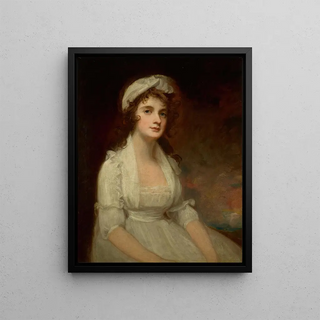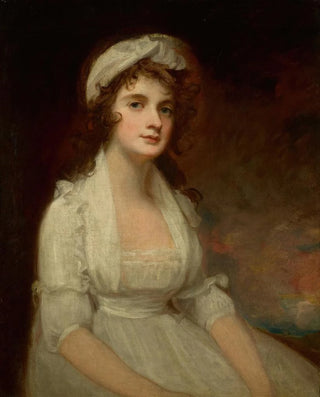Art print | Portrait of Miss Elizabeth Tighe 1774-1857 Half-length wearing a white dress - George Romney


View from behind

Frame (optional)
In the panorama of British art history, the portrait of Miss Elizabeth Tighe, created by George Romney, stands out for its delicacy and elegance. This artwork, produced between 1774 and 1857, embodies not only the refinement of the fashion of the time but also the artist's ability to capture the very essence of his models. Through this art print, viewers are invited to immerse themselves in a universe where beauty and craftsmanship intertwine, revealing an era when portraiture reflected society and morals. Miss Tighe's white dress, both simple and sophisticated, evokes timeless grace, while her captivating gaze seems to tell a personal story, full of mystery and charm.
Style and uniqueness of the work
George Romney's style is characterized by a keen sense of detail and mastery of light that give his portraits rare emotional depth. In the case of Miss Elizabeth Tighe, the artist succeeds in creating an intimate atmosphere, almost tangible, where each brushstroke seems charged with life. The texture of the dress, carefully rendered, contrasts with the softness of the model's face, thus accentuating her beauty. The choice of white, a symbol of purity and innocence, reinforces the idea of a blossoming youth, while the demi-longueur pose lends a certain dignity to the overall composition. This portrait is not limited to a simple physical representation; it also evokes a personality, an essence that transcends time and continues to fascinate those who observe it.
The artist and his influence
George Romney, born in 1734, is one of the most renowned portraitists of his era. His career, marked by a series of successes in London and beyond, testifies to his skill in capturing not only the appearance of his subjects but also their character. Influenced by great masters of painting such as Reynolds and Gainsborough, he develops a style that is uniquely his own, blending realism and idealization. Romney managed to establish himself in a vibrant artistic environment, where portraits became symbols of social status.

Matte finish

View from behind

Frame (optional)
In the panorama of British art history, the portrait of Miss Elizabeth Tighe, created by George Romney, stands out for its delicacy and elegance. This artwork, produced between 1774 and 1857, embodies not only the refinement of the fashion of the time but also the artist's ability to capture the very essence of his models. Through this art print, viewers are invited to immerse themselves in a universe where beauty and craftsmanship intertwine, revealing an era when portraiture reflected society and morals. Miss Tighe's white dress, both simple and sophisticated, evokes timeless grace, while her captivating gaze seems to tell a personal story, full of mystery and charm.
Style and uniqueness of the work
George Romney's style is characterized by a keen sense of detail and mastery of light that give his portraits rare emotional depth. In the case of Miss Elizabeth Tighe, the artist succeeds in creating an intimate atmosphere, almost tangible, where each brushstroke seems charged with life. The texture of the dress, carefully rendered, contrasts with the softness of the model's face, thus accentuating her beauty. The choice of white, a symbol of purity and innocence, reinforces the idea of a blossoming youth, while the demi-longueur pose lends a certain dignity to the overall composition. This portrait is not limited to a simple physical representation; it also evokes a personality, an essence that transcends time and continues to fascinate those who observe it.
The artist and his influence
George Romney, born in 1734, is one of the most renowned portraitists of his era. His career, marked by a series of successes in London and beyond, testifies to his skill in capturing not only the appearance of his subjects but also their character. Influenced by great masters of painting such as Reynolds and Gainsborough, he develops a style that is uniquely his own, blending realism and idealization. Romney managed to establish himself in a vibrant artistic environment, where portraits became symbols of social status.






